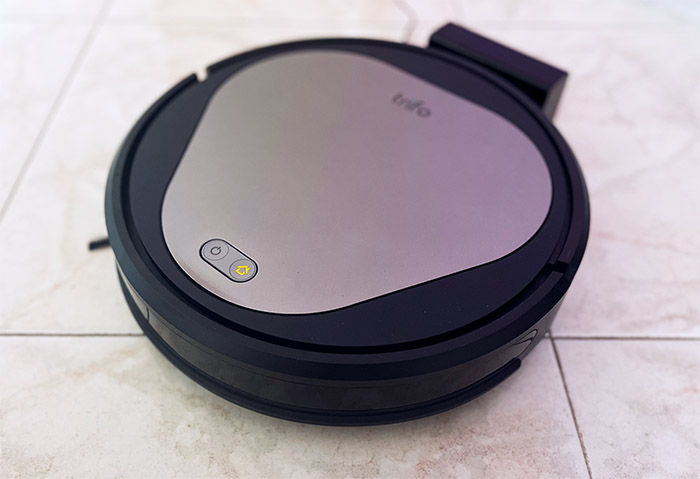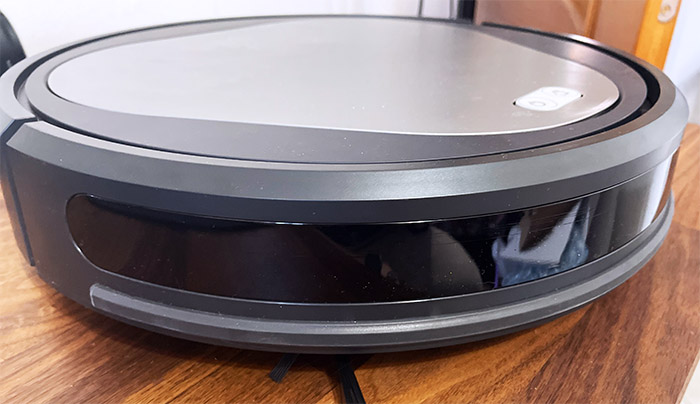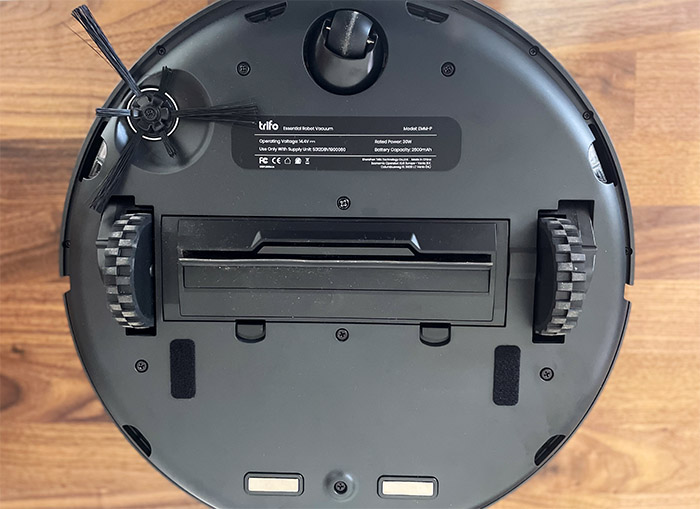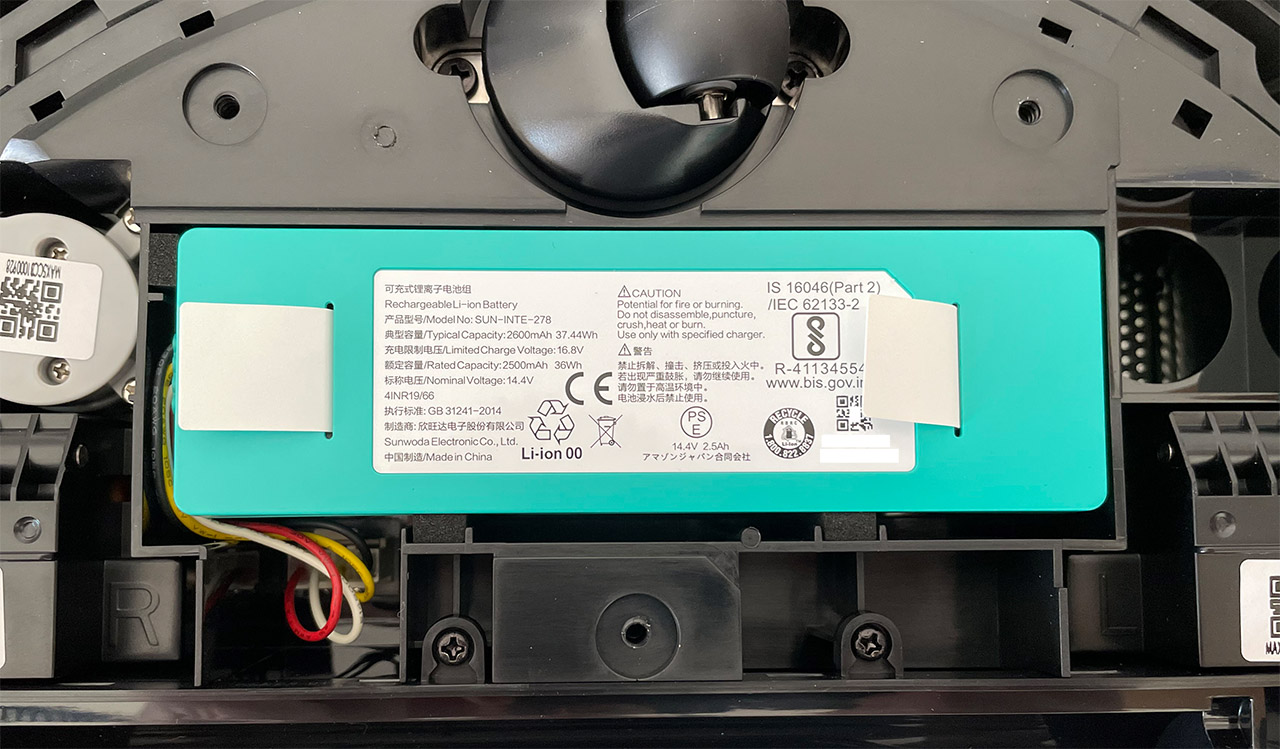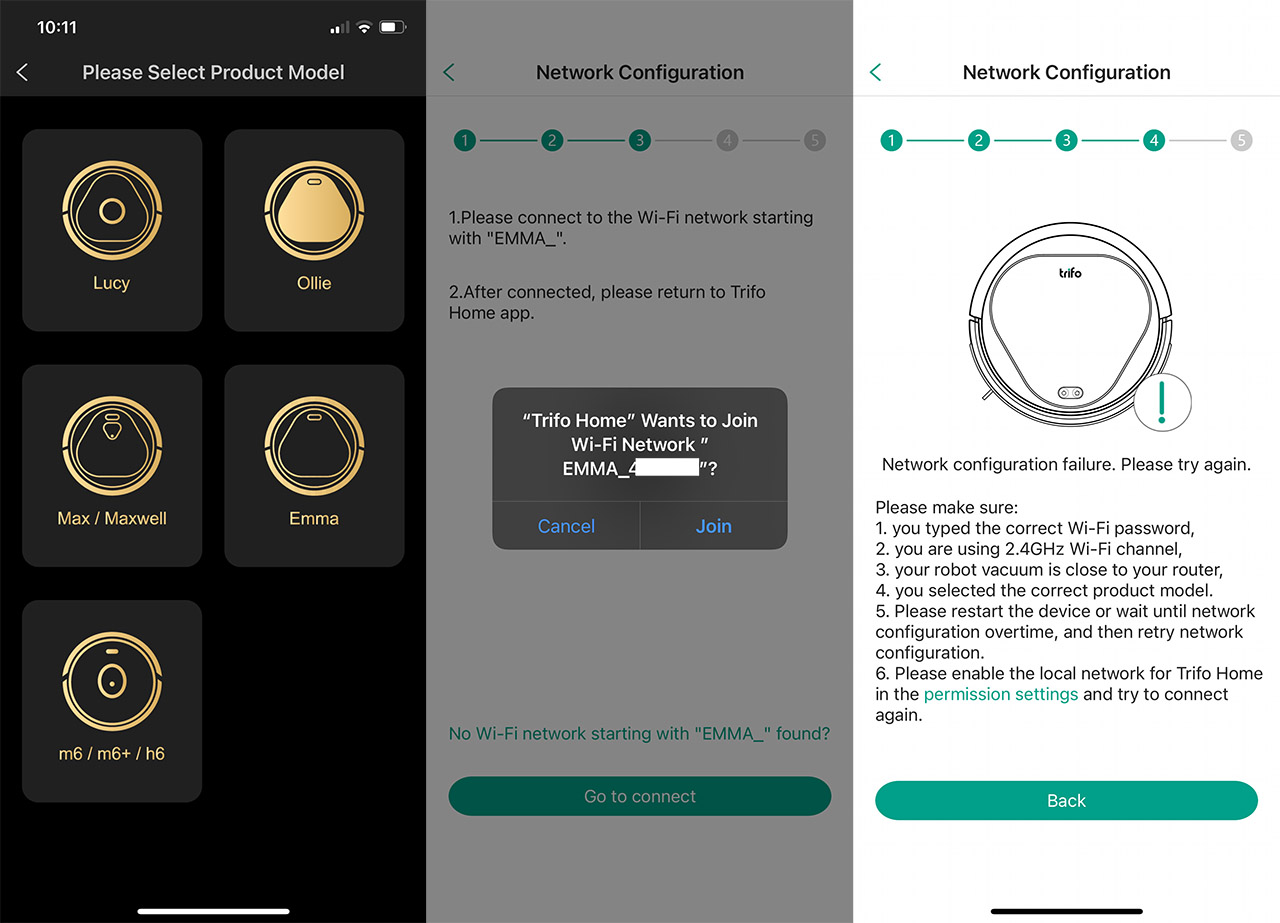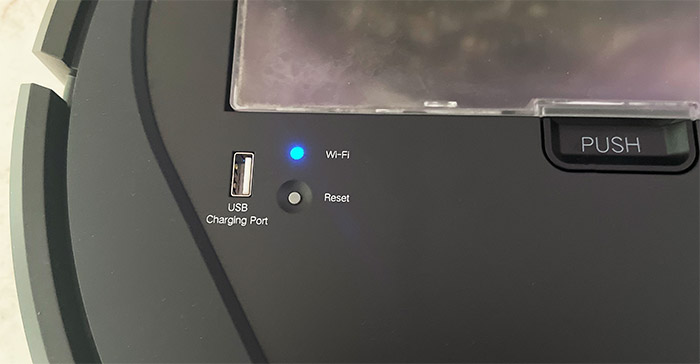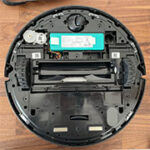The Trifo Emma Pet is currently the base model from the robot vacuum cleaner series that the manufacturer has developed, so don’t expect Lidar or the vSLAM technology (that we saw on the Trifo Lucy) because we’re dealing with a fairly no-frills device.
| Trifo Emma Pet | |
|---|---|
| Trifo.com | Check Product |
Up to a certain point because the Trifo Emma is able to create maps even without the two aforementioned technologies (in a similar manner to the Ultenic DS5 Pro) and yes, there is an app to control the behavior of the robot vacuum cleaner. Furthermore, the Trifo Emma Pet comes with the same type of mop assembly which I wasn’t really fond of when I tested the Lucy, but I think it will make much more sense on this vacuum cleaner.
And there’s also a very large 600ml dust bin. It is one of the largest I have seen on a robot vacuum cleaner so far and, paired to the 110 minutes runtime (if true), it should ensure a thorough cleaning of a large house. The suction power is 3,000Pa and I saw that the Trifo Lucy had some trouble with pet hair, so the manufacturer tried to remedy this behavior by inserting a special element to replace the rolling brush. That’s why the device is called Trifo Emma Pet, since, this way, it should handle per hair far better than other robot vacuum cleaners. That being said, let’s put the robot vacuum cleaner to the test and see if it can actually replace the good ol’ broom and dustpan.
The Design and Build Quality
The Trifo Emma may follow the usual (proven) design for robot vacuum cleaners, but it’s far bigger than most other random-navigation-type of devices, measuring 14.2 inches in diameter and it’s 3.3 inches tall. And yes, it’s just as big as the Trigo Lucy, but the manufacturer also took the opportunity to keep the 600ml (21oz) dustbin as well. The device is mostly covered by a black matte finish, with the exception of the bumper that needs the transparent plastic for the IR sensor (to find its way back to the charging station).
At the top, Trifo decided to use what looks like brushed aluminum and there’s a cut-out for the two main buttons (with LEDs). The first button powers up the robot vacuum cleaner (press and hold it to turn it off) and the second one is used to finish the cleaning cycle and return the device to its charging station. If you open the top cover (revealing that it’s made of plastic), you’ll see the same layout as on the Trifo Lucy. There is an additional way for charging the robot vacuum cleaner via the USB-A port (interesting addition), a Reset button (you need to long press it to return the Trifo Emma Pet to its default settings) and a WiFi LED (it becomes solid blue after pairing the device to the app).
Underneath the cover you can also access the dustbin and it’s easy to remove, just push on the dedicated button to pop it out. After turning the Trifo Emma Pet upside down, I realized that there’s a very similar layout to what we saw on the Trifo Lucy, so expect the two charging pins, the six cliff sensors and the same type of wheels + the 360 degrees wheel. What was missing was the optical track sensor (which works great in combination with the camera module). Furthermore, the two Velcro pads were also present (to attach the mop) and the non-removable side brush.
In the middle, there is the rolling brush which can easily be removed and, since we are using the Pet version, this brush, along with the brushguard can be replaced with the pet hair extractor. This new part looks very similar to what you get when buying a regular vacuum cleaner (where you can choose between various available heads). And in this case, there is no rolling brush to capture the hair, but a silicone flap which pushes it towards the dust bin. The hair pet extractor along with a fairly high suction power should be successful at removing hair from carpets, but we will put it to the test in a minute.
Internal Hardware: Trifo Emma Pet Teardown
I saw conflicting info on the website since the specs page showed 4,000Pa, while the main page suggested 3,000Pa, so I decided to check for myself what type of brushless motor they have added inside the case. So, it’s best to remove the bumper and the side brush before anything else, followed by the bigger screws all around the case.
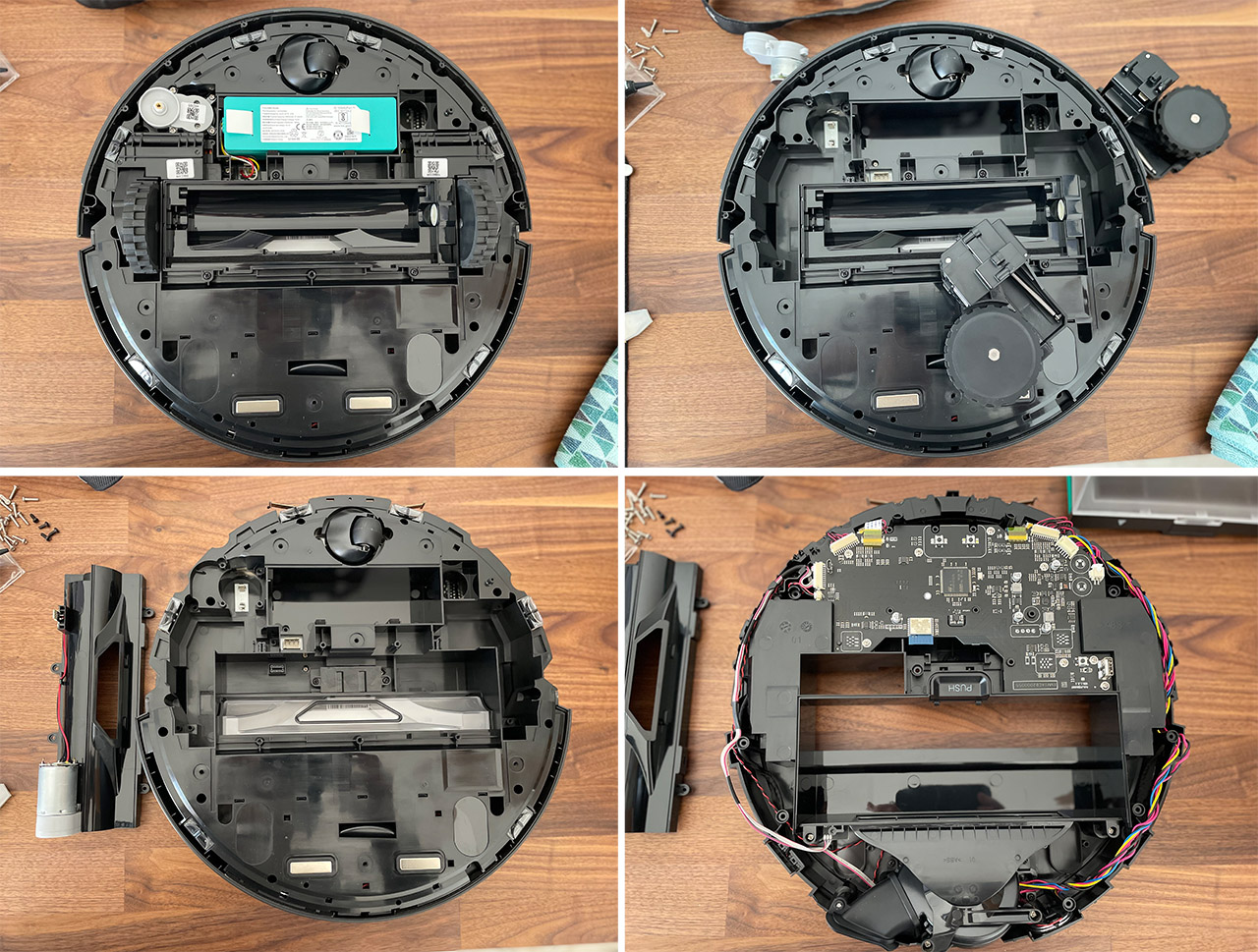
Be aware that there is a seal on top of one of the screws, so the manufacturer will most likely void your warranty in case you break it. Afterwards, the bottom cover will just easily pop out. The first thing that I was able to identify was the 2600mAh battery and, again, I was impressed by the modular approach that the manufacturer adopted with its robot vacuum cleaner line since it’s far easier to upgrade or change faulty parts (far easier to repair).
It was also very easy to navigate through the sections since there is a small amount of cables, almost everything uses direct connectors (to the board) – the same concept can be found on the Trifo Lucy as well. After that, make sure to remove the rolling brush motor (the section where you add the rolling brush) because there are a few screws underneath that you need to take out before being able to detach the entire upper section.
Doing so will expose the PCB and here, it’s possible to identify the ARM Cortex-M4 STM32F407ZGT6 CPU clocked at 168MHz and the ESPRESSIF ESP-WRQM-02D WiFi module. It was interesting to see that on the PCB, there was also a microUSB port. Lastly, after removing the screws on the other side and exposing the suction motor, I could see that it’s a Nidec 22N708R010. I checked the web which has confirmed that the suction power is indeed 3,000Pa.
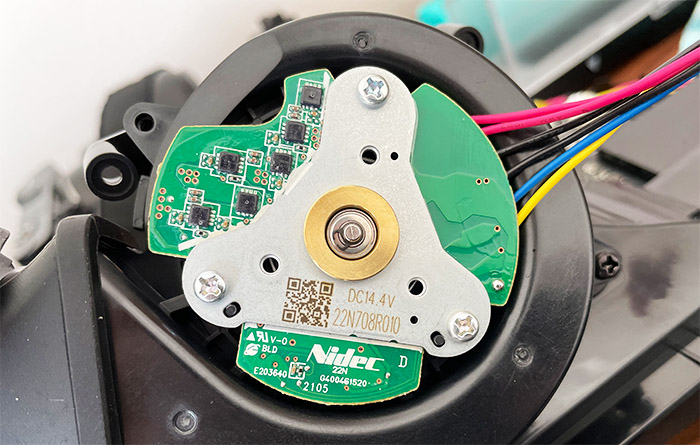
The Docking Station
The Trifo Emma Pet does not have a self-emptying station, so it can be charged using a small dock. And it’s pretty much the same as the one we saw on the Trifo Lucy, just a bit less fancy looking. The upper part is glossy black with an LED flashing at the top, while the lower section is matte black with the two metallic connectors lowering to get in contact with the robot vacuum cleaner. At the bottom, the manufacturer has kept that detachable cover that allows an easier cable management.
The Mobile App
While most robovacs, especially in this price range do come with a remote control, Trifo decided against it, so the only way to control the Emma Pet is via the mobile app. And this came with some problematic consequences that we’ll briefly explore. The app is called Trifo Home and it’s the same for (currently) all robot vacuum cleaners from this brand. After logging into the account that I made when I tested the Trifo Lucy, I tapped on the Plus sign and selected Emma.
Then, I powered on the device to hear the usual uplifting song and the charging voice notification which is less startling than on the Trifo Lucy. The app instructed me to press and hold the Home button for 5 seconds and the voice notification will say “Let’s connect me to your home WiFi”. At this point, the app wanted access to your Location and, I said no, so the app simply threw me out. Here we go again. I decided to let it have an approximation of my location and I had to connect my phone to the 2.4GHz network. And then I had to enter the credentials by myself regardless (wow).
After that, I had to manually connect to the EMMA_ WiFi and, I got the error that the connection to the network had failed. I tried again from the start (with the precise location – sigh) and it failed once more. I started to assume that maybe the battery was too low, so I let it charge up before trying again. A snack later, I returned and tried the process to see it failing once again, even after I restarted the phone that I was using. At this point I realized that maybe it’s the phone. So, I put the iPhone 12 on the side and tried the same steps on an Android device. It got paired in 30 seconds. I have no idea what is going on considering that I could pair the Trifo Lucy using the iPhone, but the Emma stubbornly refused to install.
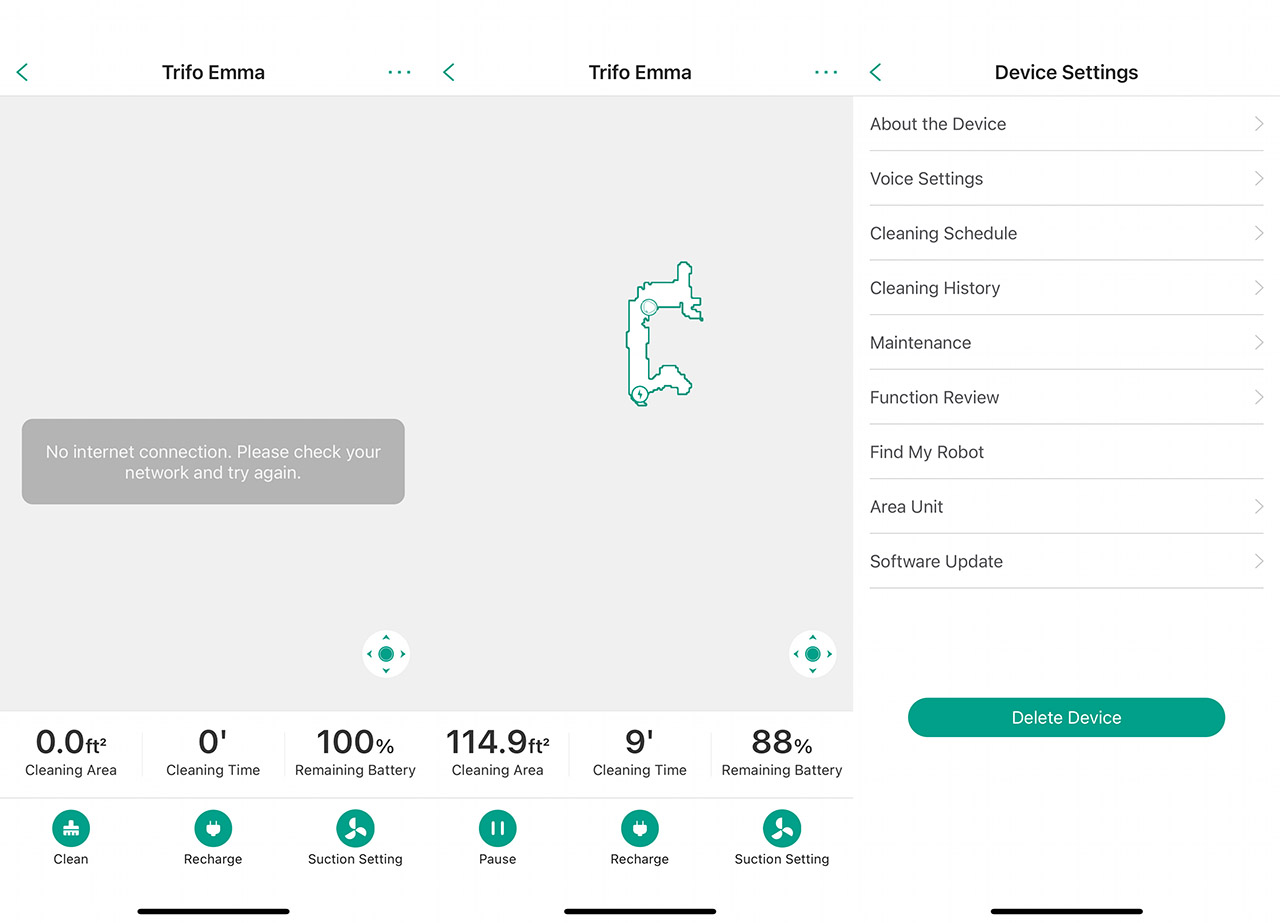
In any case, after adding it via an Android smartphone, it appeared in the list of the iPhone and I could use all the available functions. Another problem is that the app will not work at all if there is no Internet connection – a remote would have allowed offline house cleaning. That being said, the app GUI is very similar to what we saw on the Trifo Lucy, just with less options available. Most of the window is occupied by the map (multi-floor maps are not supported, as expected), while towards the bottom left, there is a small icon which will enable the Manual Mode (you should be able to move the Trifo Emma Pet by manually using a virtual joystick).
Further down, you can see the Cleaning Area and the Time it took, as well as the Remaining Battery. Then, there’s the action buttons, the first starting the Cleaning process, the next will return the Trifo Emma to its base to Recharge it and lastly, there’s the option to change the Suction Setting. If you tap on the three dots from the top right corner, you can change the language and the volume of the Voice notifications, set a Cleaning Schedule (you can also view the History), update the software, check the location of the device (in case it gets lost) and more.
The Performance
The Noise
As, I saw with the Lucy, the Trifo robot vacuum cleaners are noisy and the same is true for the Trifo Emma Pet as well. I think that the reason is the powerful exhaust mechanism, which is why even if I moved through various suction levels, the noise didn’t actually rise up that much, especially at the lower levels.
Also, know that there aren’t 3-4 fixed levels (as on other robot vacuum cleaners), you move along a slider which breaks the suction speed into about 10 levels. The lower levels (up to one third of the slider), the noise levels ranged between 53 and 56dB, while the middle suction levels showed that the noise went up to 58dB (about 2 feet away from the robot vacuum cleaner). Raising it further to about 2 thirds of the slider showed that the noise ranges between 60 and 63dB, and the last two portions of the slider (the maximum suction power) showed that the noise levels can go past 70dB, up to 73dB.
This means that there is no chance to sleep while the Trifo Emma Pet is vacuuming the house and that it’s about as loud as the traditional vacuum cleaner. Also, there’s the loud voice notifications which can be silenced and I do need to mention that the the speaker is less clear on the Emma than it was on the Lucy.
The Navigation
I am always wary of robot vacuum cleaners that lack the Lidar or the vSLAM technologies since, during my tests, the implemented algorithms aren’t that great at creating a proper map, so the devices end up vacuuming the same area obsessively and then they have trouble returning to the base station. Is that also the case with the Trifo Emma Pet?
In general, no, but it does have it’s own set of issues. As expected, you should not leave any cables or shoe laces around since they will be eaten up by the Trifo Emma Pet. But, I was surprised to see that the device was able to create a fairly accurate map and it would also show in real-time the position of the robot vacuum cleaner. It’s quite the feat since the Ultenic D5S Pro struggled with it. Then, the cliff sensors worked wonderfully well and there was zero chance that it would fall down the stairs, as can be seen in the video. But, the robot vacuum cleaner does have the tendency to go over the same spot multiple times (I counted between three to four times) which is good for thorough cleaning, but not so great for battery life.
Then, I saw that it failed to detect that there were other areas available where it could have gone and cleaned. Furthermore, probably the worst offender was the fact that the charging station was detected in the map and the icon was properly set. But the robot vacuum cleaner would move and toss it around while cleaning that space. It actually took me by surprise since it happened twice during the same cleaning cycle. Probably an IR issue, but then again, after the cycle was done, the device went straight to the docking station and carefully attached to it. The algorithm clearly needs some fine tuning in this regard. At the same time, as I mentioned, the Trifo Lucy is the first robot vacuum cleaner that I tested which quickly and accurately returns to its base even if it uses the random-type navigation system.
Trifo Emma Pet
-Pros
- The app creates a map of the house
- Large dustbin
- Accurately finds its way back to the charging station
- Pet hair extractor module
- Affordable
Cons
- The wizard installation is not successful when using an iPhone
- The device does not go in every part of the room
- No way to set No-Go Zones
- No remote control

Mark is a graduate in Computer Science, having gathered valuable experience over the years working in IT as a programmer. Mark is also the main tech writer for MBReviews.com, covering not only his passion, the networking devices, but also other cool electronic gadgets that you may find useful for your every day life.

